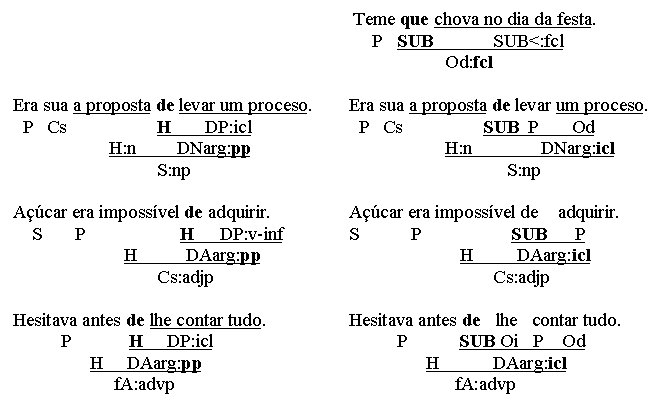| Portuguese VISLSentence AnalysisEdutainmentCorporaDictionariesMachine Translation |
Eckhard Bick
PORTUGUESE SYNTAX
4. Subordination
In Portuguese, both finite (a-b) and averbal (c-d) subclauses are obligatorily introduced by a complementizer (clause header) , while non-finite subclauses only feature complementizers in special constructions (e-f). Consider the following (subclauses underlined, complementizers in bold face, word class in parenthesis):

As shown in the examples, complementizers can be subordinating conjunctions or relative pronouns. The relative pronouns have their own specific argument or adjunct function within the subclause, - in the examples quem (b) is a subject (S), while onde (e, b) and como (f) are adjunct adverbials (fA). Subordinating conjunctions, on the other hand, like que in (a) and embora in (d), have no argument or adjunct function within the subclause - they have only the subordinating function (SUB) of a clause header.
In subclauses with subordinators, one could then distinguish between the complementizer as a kind of "clause head", and the remaining clause body as its argument. The function tags used will be subordinator (SUB) for the former, and subordinator argument (SUB<) for the latter. Though not a primary constituent of ordinary clauses, the SUB< category can be useful in describing co-ordination and averbal clauses:
(a) Vou convidá-la, embora seja desconhecida e não mereça muita atenção.

(b) Quando em Roma, faça como fazem os romanos.

As discussed in the chapter on clause types, a robust definition of what is a clause in Portuguese can be based on whether a constituent contains at least one verb and/or a complementizer. According to this definition, quando em Roma is an averbal clause, since it contains a complementizer (quando), but no verb.
If we want to improve on the dummy function SUB< (complementizer argument) for acl-clause bodies, we could consider C(s) for jovem in embora jovem, and A(s) for em Roma in quando em Roma, the functions that would be used with an explicit copula (embora seja jovem, quando estiver em Roma). As a matter of fact, some grammarians would argue that what we have called acl, is a full-fledged clause in its own right, - with a "zero constituent" (the elliptic verb) . Zero constituents do not, however, make sense in a word based dependency grammar like CG, and can be difficult to maintain pedagogically.
A special kind of acl subordination is the use of the relative adverb como as comparative (SUBcom) or predicative (SUBprd) subordinator, typically in connection with a noun or noun phrase as acl clause body (SUB<).

In terms of valency, the acl's of both (1) and (2) are adjuncts, but are they adverbial adjuncts? In spite of its (clause) form, one might argue that at least (2) functions much like an fC (subject adjunct or adjunct predicative), offering predicative information about the subject: "é/parece guia". Consider also:


Now, "real" clause level function (fA for como and S for um escravo) can be assigned in stead of the functionally "poor" SUB and SUB<.
For (2), the zero predicator solution doesn't work the same way (*Trabalha como [trabalha] guia), which is one of the (syntactic) reasons for making the distinction between (1) and (2) in the first place. Introducing an additional clausal layer one could instead try a copula trabalha como [quem é/parece] guia yielding a predicative Cs function for guia (as above suggested for the whole acl). As a matter of fact, a copula predication can be inferred from (2), but not from (1):
Trabalha como guia. -> é/parece guia
Trabalha como um escravo. -> *é/parece escravo
Furthermore, the construction in (2) is reminiscent of a pp (prepositional phrase).

In fact, many grammarians would classify como in these cases as a preposition, and the acl's as pp's, breaking the terminological link to other averbal constructions like quando em Roma and embora jovem. On the other hand, if some let prepositions usurp the place of subordinators, why not argue that prepositions are themselves a kind of subordinator? After all it is prepositions that - in Portuguese - are used to subordinate argument clauses to nouns, adjectives, adverbs and auxiliaries, in fact, to everything but other clauses. In the examples, prepositions are analysed both traditionally (on the left), i.e. as (head-) constituent of a pp, and (on the right) as subordinator within a non-finite clause (icl).

One of the interesting things about comparing the pp- and icl- analyses is that they are structurally the same from the pp/icl-level upward, with nodes and branches in the same places, but differ form the pp/icl-level downward, the icl-analysis being structurally flatter and "simpler", since the SUB< -node corresponding to the pp-analysis' pp-node is superfluous, placing the icl's own constituents (P, O etc.) on the same level as the preposition-subordinator itself.
| symbol | category |
|
|
| SUB | subordinator
subordinador subordinator |
|
|
| SUBcom
COM |
comparative
subordinator
subordinador comparativo komparator |
|
|
| SUBprd PRD | predicative
subordinator
(role complementizer) subordinador predicativo rolleindleder |
|
|
| SUBaux
PRT-AUX |
auxiliary
subordinator
subordinador auxiliar (partículo auxiliar) auxiliarpartikel |
Você acabou de entrar na Home Page da universidade de Århus. Hipopótamo tem que dormir muito. |
|
| SUB<
AS<, C< |
[averbal]
clause body
tronco de oração [averbal] sætningsstamme (indlederkomplement) |
|
|